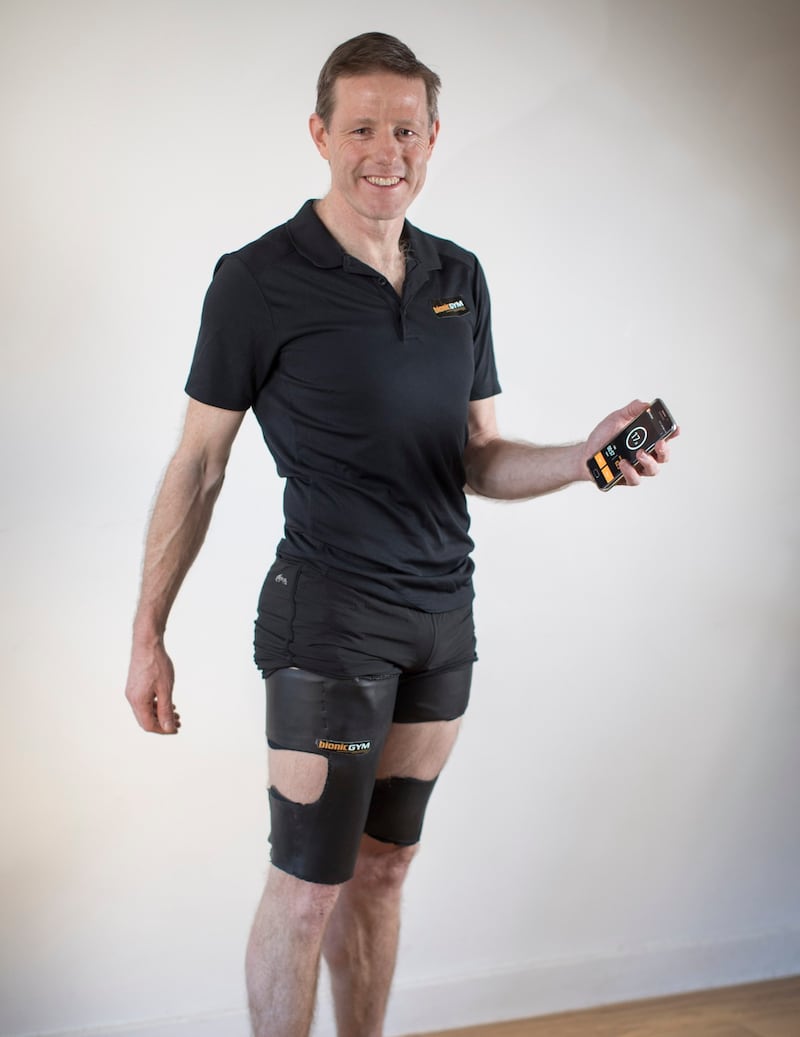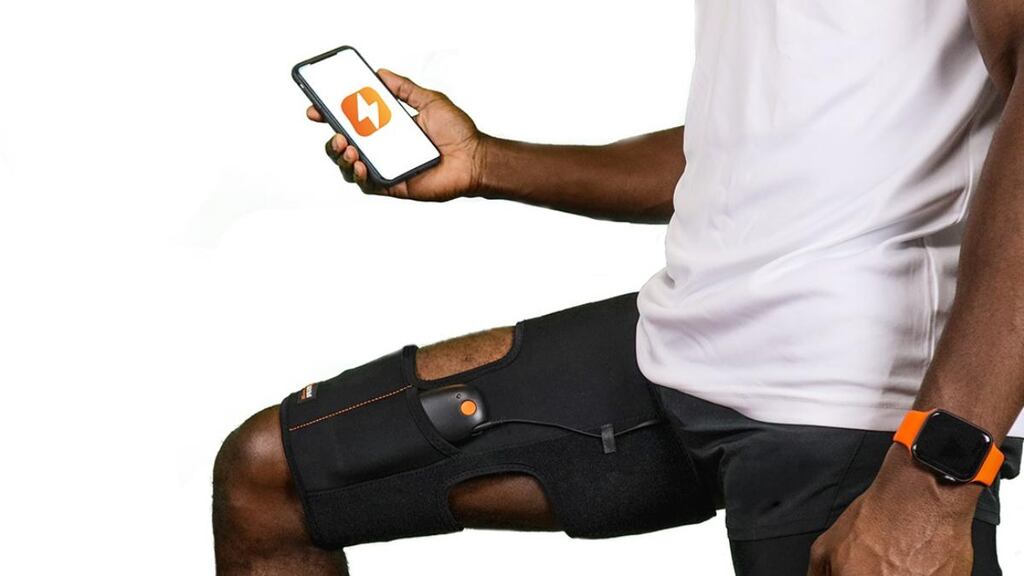It was a swimming session in the Irish Sea that planted the idea for BionicGym, specifically one that occurred in the Irish Sea. Louis Crowe noticed he was shivering, but that it was synchronised: his teeth were chattering at the same pace as his legs were shaking. It was then he decided to explore the idea of using shivering as a form of exercise.
It sounds a bit wacky, but there is method to it. Shivering, apparently, can actually burn calories – about 100 in 15 minutes. But who wants to be cold just to lose weight? Tap into that shivering mechanism without the cold, he reasoned, and there may be a way to use it as cardiovascular exercise, through neuromuscular electrical stimulation.
It has taken 20 years from that first realisation to BionicGym becoming a reality. In the meantime, Crowe worked for Bio Medical Research – makers of Slendertone – before eventually pursuing BionicGym himself.
A big part of that was turning to crowdfunding. When BionicGym started its first campaign on Indiegogo in 2016, its founder was confident it could be delivered within the deadline he had set. The company had set out to raise $20,000, with the aim of delivering the product by November 2017. That gave them almost a year to get it built, tested and ready for production; he believed eight months would be sufficient, but was allowing a buffer. When you are a start-up, though, things don’t always go to plan. As is so often the case with new products, that deadline slipped a little, and then a little more.
The product continued to attract attention – and its fair share of sceptics
Losing the company’s chief technology officer was one setback. Then there were issues with quality control on vital components of the boards inside the product.
“All of a sudden, we had no one developing it,” says Crowe. “So we outsourced the development of the project as a whole, and that’s been challenging but we eventually got here.”
Success story
That was where Shannon-based Gentian came in. BionicGym is somewhat of an Irish success story. The product is not only developed and designed in Ireland, it is also being manufactured here. Although the option was there to go with, Crowe said part of the reason for choosing Gentian for the project was down to being able to oversee each stage.
“We need to pay too much attention to the details,” he said. “We needed to take control of the details and the product development, particularly the pulses. It’s the difference between people having a comfortable experience and not at all.”

The app is also being overseen by an Irish company, Greenfinch, a project that had formerly been given to an Asian company.
The delays have led to a bit of a headache for backers, and for Crowe, who saw numerous deadlines come and go with no product to show for it.
“Our backers have been, by and large, very gracious and patient,” he says.
In the meantime, the product continued to attract attention – and its fair share of sceptics.
BionicGym has now raised more than $3.3 million (just over €2.9 million) through Indiegogo to fund BionicGym’s development. That alone was a milestone for the company.
Last year a small group of beta testers got their hands on the device, working out the kinks and giving their feedback – another small step towards the finished product.
But as of February 2019, BionicGym is now shipping to backers, marking another milestone.
“By next week we’ll have a few hundred using it,” he said. “It’s such a relief.”
Pulse racing
The current BionicGym set up consists of three items: two leg wraps, the app and the control unit, which is essentially the brains of the entire operation. It is the control unit that connects to the electrodes in the wraps, grabbing the workout programmes from the app and translating it all into a series of pulses to stimulate your muscles. To put it in context, the app is free, the replacement gel pads for the electrodes are $30 for a set of eight and the wraps are $109 per pair.
If you take the videos at face value, BionicGym certainly has a physical impact on the user. The muscle twitching, the sweat, the breathlessness; none of it looks particularly comfortable.
It all sounds a bit, well, out there. Put on these leg wraps and shiver your way to fitness. With every hunting for a fitness quick fix, scepticism is inevitable. Neuromuscular electrical stimulation has therapeutic uses, but as a cardiovascular workout? BionicGym doesn’t have large-scale clinical trials to back up its claims, although the company does point to scientific studies that it says will prove the theory behind the device.
When it comes to products promising the world, a bit of scepticism is probably healthy. But Crowe stands over his product.
Whatever about the science behind it, it seems that the users of BionicGym have embraced it. Crowe himself claims to have run a marathon from his sofa while using the device – although experienced marathon runners will appreciate that it’s not the only training you should undertake while preparing yourself.
There’s a certain amount of responsibility when developing fitness-focused products, and it’s something that BionicGym appears to be considering. Part of that, it seems, is a phased release for the new workouts.
“It takes a while to get used to it, and some people more than others,” Crowe says. “We just want to make sure everyone has a positive experience. If they jump straight into some HIIT sessions, they’ll really know it.”
FDA approval
Among the test groups for the technology has been men with type 2 diabetes. Crowe also used the European Space Agency’s test facility to trial the technology in zero gravity, although there is no suggestion that the agency is about to embrace the technology for astronauts.
“I’ve been researching this over 20 years. It’s evolving and improving all the time,” Crowe says.
It has been a learning experience for BionicGym, too.
The next hurdle for the company is getting FDA approval – a process that has been in train for months
“One of our lessons is that there are a lot more people at extremes than we had anticipated,” he says. “We thought most people would be in the middle using it. But we have really tall people and small people, and we have some really large people, too. At the slim side as well, we’ll need to optimise things for the 1 or 2 per cent that are the extreme.”
The product, however, has its limitations, specifically for larger women. It’s not recommended for women over 101kg – mainly Crow says, due to differences in fat distribution on the body. Many of the initial backers were male, says Crowe, who attributes it to the demographic of crowdfunding. “Thankfully it is evening up now; we’ve got lots of women and they are giving feedback as well.”
So the product is shipping, but it’s not quite ready for the mass market. The next hurdle for the company is getting FDA approval – a process that has been in train for months. Because the FDA has classed BionicGym as a medical device, the company needs FDA approval before it can ship to US backers.
In the meantime, it has to hope that the long wait has proved worth it for its backers.











